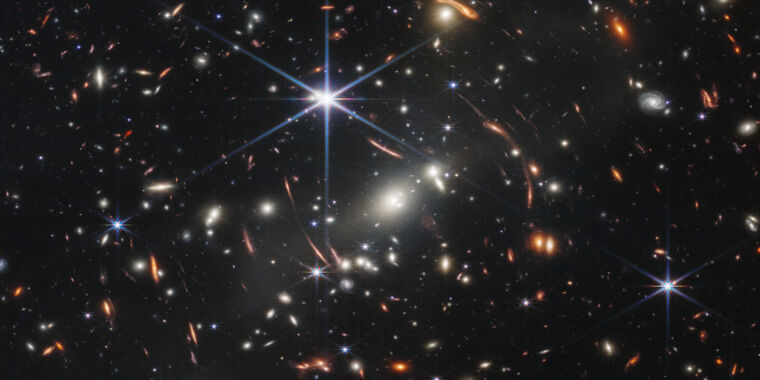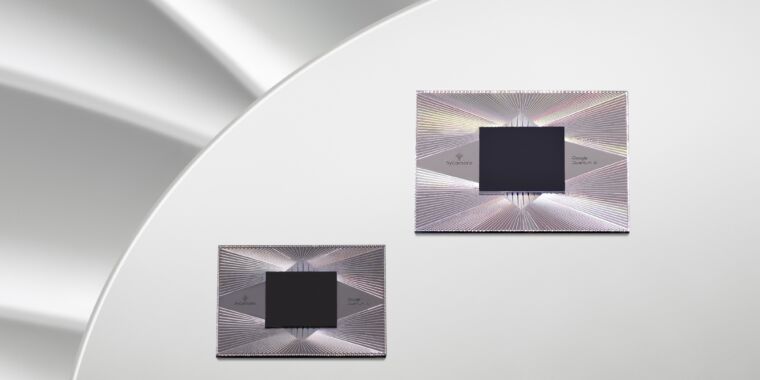
How soon after the Big Bang could stars and galaxies start to form? It has been a difficult question to answer, as much of the light from the first stars has been shifted deep into the infrared during the billions of years it has spent traveling to Earth. One of the design goals of the Webb Telescope was to create a telescope that could pick up this light and tell us something about the early history of the Universe. And initial data has been very promising, with astronomers seemingly racing each other to find the most distant galaxy yet observed.
Now, a new study looks into the properties of a set of distant galaxies, showing that one of them appears to be larger than the Milky Way at only 700 million years after the Big Bang. If the results hold up, then the number of galaxies of this size may be difficult to reconcile with the forces we think built the Universe.
Going deep
The technique for spotting early galaxies is fairly simple. The earliest stars and galaxies were embedded in a Universe filled with hydrogen atoms, which can be ionized if they absorb light at specific wavelengths in the UV range. This absorption creates a distinctive feature in the light arriving from distant galaxies. Over the billions of years it takes to reach us, however, that feature has been red-shifted by the expansion of the Universe so that now it appears deep in the infrared portion of the spectrum. If you can identify where it resides, then you can determine just how far away the galaxy is.
For the new work, a team of astronomers searched a patch of the sky for galaxies where they could identify two specific features, both due to the ionization of hydrogen. This led to a group of 13 galaxies with redshifts that placed them between 500 million and 900 million years after the Big Bang. That means that the light from them had traveled for roughly 13 billion years before reaching Earth.
Simply knowing the galaxies are there is useful. But it’s also possible to estimate some of their properties, which can tell us how quickly galaxy formation and evolution took place. These estimates are based on the ratio of the intensity of the hydrogen features relative to the light deeper into the infrared, which includes much of the starlight emitted by these galaxies.
Several methods are available to model the properties of these galaxies, and the research team ran all of them—including one using five different configurations. This was meant to provide a range of values under the assumption that the actual value was likely to fall within this range.
Big stuff
The brightest of these galaxies is unexpectedly large. At the high end of the estimates of its mass, it’s roughly 1011 times the mass of the Sun, which makes it larger than the Milky Way by this estimate. Yet it appears to have that many stars about 700 million years after the Big Bang—galaxies with this mass simply haven’t been seen at this distance before. It appears to have at least two nearby companions, and so may be part of a cluster, which could have influenced its growth.
While it’s the largest member of this sample, however, the whole sample tends to be on the unexpectedly massive side. In fact, if these galaxies are represented, then most of the stars of the early Universe were in massive galaxies. It’s either that, or we’ve not had much success in finding low-mass galaxies at these distances. One thing that would argue that these galaxies aren’t representative is that it’s tough to form this many high-mass galaxies given our current understanding of how dark matter and dark energy shaped the evolution of the early Universe, because there simply may not be enough regular matter to form that many stars. These galaxies “push against the limit set by the number of available baryons in the most massive dark matter halos,” the researchers indicate.
The alternative, of course, is that the mass estimates are wrong in some way. One possibility is that the methods used to estimate mass were developed using examples that were a bit more recent, and so they don’t produce accurate results when used on more distant galaxies.
Fortunately, figuring out what’s going on will just take time. This was only one small area of the sky, chosen for study because it had been imaged previously by the Hubble. There are definitely additional areas we already have data for, and they should tell us whether the tendency toward massive galaxies is a general feature of the early Universe.
Nature, 2023. DOI: 10.1038/s41586-023-05786-2 (About DOIs).








